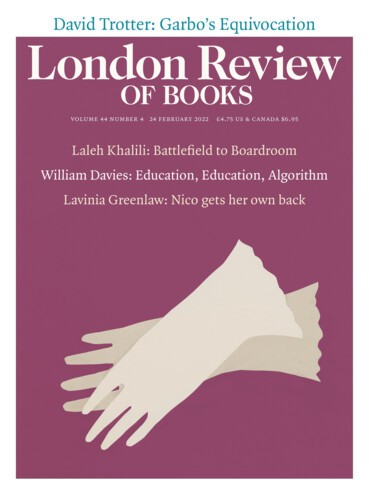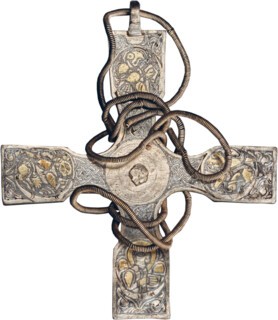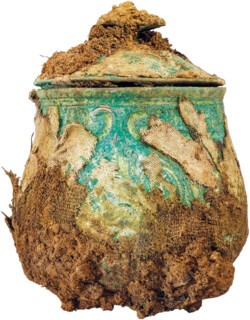In September 2014 a group of detectorists were searching a field in Balmaghie, Kirkcudbrightshire, in south-west Scotland, when one of them got a signal. This wasn’t entirely unexpected. There had been some small finds close by: a coin, some scattered silver. But when Derek McLennan dug down, he pulled out something more substantial, a silver arm-ring. The story goes that he immediately shouted ‘Viking!’ Buried alongside it were a decorated silver pendant cross on a chain of very finely coiled silver wire (which turned out to be Anglo-Saxon, but could still be Viking loot) and a layer of silver bullion – arm-rings, ‘hacksilver’ and ingots made from melted down silver coins and scrap.
McLennan reported the find to Dumfries and Galloway Council, and an archaeologist arrived that afternoon to oversee the excavation. They had finished by the end of the day, but the detector kept recording a signal. The cross and the bullion had been laid on a four-inch bed of gravel, so the team dug up the gravel, revealing a much larger deposit: twice as much silver as the top layer, wrapped in leather; a cluster of four elaborately decorated arm-rings bound together, enclosing a wooden box containing a gold ring, a gold ingot and a gold bird pin; and a lidded silver-gilt pot. The pot was carefully wrapped and packed with beads, a pendant, a brooch, three filigree mounts, another gold ingot and a twisted rod, as well as some truly mysterious items: two ‘dirt balls’ and an object called a ‘rattlestone’, also carefully wrapped. In their catalogue to accompany an exhibition of the hoard (at Kirkcudbright Galleries until 10 July), Martin Goldberg and Mary Davis suggest that the top layer was a ‘decoy’. If someone tried to make off with the hoard, or a piece was turned up by ploughing, the discoverers would find the cross and the silver and be so pleased that they didn’t look any further. (In which case, the plan nearly worked.)
In total the Galloway Hoard amounts to five kilos of silver, making it the largest deposit of Viking Age silver found in Scotland since the eight kilos discovered at Skaill, Orkney in 1867. It’s also ‘the largest surviving collection of gold objects from Viking-age Britain and Ireland’ – Sutton Hoo was pre-Viking, as was the Staffordshire Hoard. But far more important than the gold and silver is the information they carry. Goldberg and Davis claim that once the articles have been examined, ‘we will know so much more … than we did’ about the world of the original owners and the people who deposited them. No doubt that’s true, but figuring out what it all means won’t be easy. Take the ‘dirt balls’. Why would anyone carefully wrap up and arrange little balls of dirt, even if they do contain tiny flecks of gold? Goldberg and Davis suggest that they might be relics from Rome, where Vatican collections contain soil from Bethlehem, Jerusalem and other holy sites. The gold flecks could come from the sealed pot they were found in or from some gold object in which they had previously been placed. But why would Vikings (if they were Vikings) have found the balls valuable? Did they think they were valuable in themselves or were they hoping to sell them on to someone from the Christian world?
The archaeologists are fairly confident that the hoard is Viking era, which means later than 800 AD, and that it was deposited ‘some time before 900 AD’ – probably later rather than earlier in the ninth century. How do they know? The first guide to the age of a hoard is often the presence of coins minted for kings whose dates are known. The Silverdale Hoard, discovered in Lancashire in 2011, amounts to only two pounds in weight, but it contains 27 coins, including some of King Alfred. The ninety-pound Cuerdale Hoard, discovered by the River Ribble in 1840, far larger than anything else from the Viking Age ever found in Britain or Ireland, contains close to seven thousand coins. But the Galloway Hoard has only one coin, with a hole in it, and that was minted for King Coenwulf of Mercia (who died in 821, before the Viking Age really got going). On the other hand the hoard contains, very unusually, well-preserved organic materials – wool, leather, even silk – that can be carbon dated, though of course the materials might have been old when it was deposited.
It’s one thing to accept that the hoard is Viking Age, but did it have anything to do with Vikings? The silver-gilt pot is useful here, not because it’s a Viking pot but because it comes from so far away. Goldberg and Davis think that the motifs are Zoroastrian and that the pot came from somewhere like Samarkand. Who else had contacts as far away as the Silk Roads? Another, and perhaps better, indication comes from the silver ingots and arm-rings that form the bulk of the hoard. The standard unit of wealth in the Viking world was an ounce of silver, which weighed 26.6 grams (we know from the discovery of lead weights in Dublin that were used as balances), slightly less than a modern ounce. Several of the rings and ingots in the hoard weigh in at exact multiples of the Viking ounce, too many to be a coincidence.
More confusing are the four names engraved in runic letters on the arm-rings. The letters are in the Anglo-Saxon script and they are all Anglo-Saxon names, or name elements. The longest is Eggbrect, or ‘Egbert’ as historians call him nowadays. The others are Ed, which could mean ‘riches’ or be short for Edward; Til, which could mean ‘good’ or be short for a name like Tilwine; and Bera, which is hard to relate to any known Anglo-Saxon name but means ‘bear’ in Old English. Each of the four arm-rings has been ‘treated in a distinctive way, which corresponds to groups of similar folded and flattened arm-rings within the silver bullion’. One might also note the four arm-rings bound together around the gold box, perhaps the sign of a ‘binding contract’. In which case – but now we are heading into the realm of historical fiction – the hoard might have been the property of four félagar, Old Norse for ‘fellows’ or ‘partners’, people who share their fé or possessions; all of them, however, with names that could be English. There were indeed English Vikings, and at about this time too.
There are other possibilities, arising from Galloway’s ethnic and linguistic character. Five hundred years before the hoard was deposited, at the time the Romans abandoned the island, Britain was about as linguistically homogeneous as it has ever been. From one end to the other, people spoke dialects of Early British, a P-Celtic language. Its southern dialects survived to become Welsh, Cornish and Breton, while its northern dialects vanished as living languages but left enough traces for philologists to form some idea of them. This linguistic unity came to an end in the fifth century, after the Roman departure from Britain, with the arrival from the east of incomers speaking Old English (Anglo-Saxon), and from the west of people speaking Irish Gaelic, a Q-Celtic language. (Fifteen hundred years ago the two branches of Celtic seem to have been about as mutually comprehensible as modern Dutch and modern German.) The Anglo-Saxon incomers initially settled along the coasts of eastern England, the Irish speakers especially in western Scotland, where they founded the kingdom of Dál Riata.
This left its mark on Galloway, which at the time of the hoard was perhaps the most linguistically and ethnically mixed part of Britain. Balmaghie itself is a Gaelic name, often said to be derived from Baile Mhic Aoidh, ‘the seat of the McGhee family’ – though bal-na-geigh, ‘pool of the marsh’, seems just as likely. Just a few miles north, however, lies Shirmers, on the east bank of Loch Ken. This isn’t Gaelic, but a name deriving from Old English, scir-(ge)mære, ‘shire boundary’. The highest hill in Galloway, to the west, is the Merrick, from Old English (ge)mære-hrycg, ‘boundary ridge’. Two miles south-east of Balmaghie, meanwhile, lies Threave, its name derived from Early British (compare tref, ‘homestead’ or ‘hamlet’ in early Welsh). From the 2700-foot summit of the Merrick, on a clear day, you can see the Isle of Man to the south, once a hornet’s nest of Viking raiders (though Manx is a Q-Celtic language), and to the north Dumbarton Rock, ‘the dun or fortress of the Britains’, stronghold of the linguistically British or P-Celtic Kingdom of Strathclyde.
What this tells us is that, perhaps three centuries before the hoard was buried, English speakers hacked two or three ‘shires’ out of the British-Celtic countryside, radiating out from Whithorn (Old English hwít-ærn, ‘white hall’) or Kirkcudbright (‘Cuthbert’s Church’, dedicated to the Northumbrian saint, but with Norse pronunciation and Celtic word order). The place names help us to map the old shire boundaries. With the collapse of their parent kingdom of Northumbria, destroyed by the Vikings not long before 900, these shires must have felt extremely vulnerable, with powerful and probably vengeful British kingdoms to the north and east, and a shoreline exposed to Irish and Norse raiders to the south and west. Their inhabitants may even have welcomed Norse settlers – there are about forty Norse placenames along the coast, including Borgue, from the Old Norse borg, ‘fortress’ – as reinforcements against the British and protectors against the settlers’ own Viking cousins.
The name Galloway itself is thought to derive from Irish gall-gaedhíl, literally ‘foreigner Gaels’. These were probably – at this place and time everything has to be qualified – linguistically and ethnically Irish, but they had ‘gone Scandinavian’, rejecting Christianity and adopting a pirate lifestyle. Unsurprisingly, everybody hated them. One Irish chronicler writes that bad as the Vikings were, the gall-gaedhíl were worse. A characteristic Norse reaction comes in the Icelandic Njal’s Saga, which features a character called Thjostolf, ‘a Hebridean by descent’ (that is to say, coming from a mixed Norse-Gaelic area). Surly and ready to kill on command, Thjostolf isn’t accepted into the Icelandic community, despite his Norse name and part-Norse ethnicity. He is eventually disowned by his patroness, and murdered by one of the many neighbourhood hard men.
So who deposited the hoard? The Anglo-Saxon names on the arm-rings could be native to Galloway’s Anglian shires. But the pectoral cross must surely be loot, and X-ray imaging has shown that a rock-crystal jar bears an inscription, under three layers of wrapping, which says (in Latin): ‘Bishop Hyguald had me made.’ Bishop Hyguald was probably Bishop of Hexham in north-east England or of Whithorn in south-west Galloway. This must also be loot, taken by pagans. But that description would fit the gall-gaedhíl as well as Norse Vikings, not to mention the English apostates.
As for the question of why it was buried, it’s often thought that hoards were a product of instability and insecurity. The massive Cuerdale Hoard, for instance, with its thousands of coins giving a date of 903-10, is believed by some to be the war chest of a Viking group that retreated to York after the expulsion of the Vikings from Dublin in 902. It’s a bad sign if a hoard had a sole depositor who never retrieved it, worse if there were several depositors, and very bad indeed if no one from a whole warband (or pirate crew, in later years) survived to come back for it. Since instability and insecurity were the norm in Viking Age Galloway, however, this doesn’t help narrow things down. Indeed, the late ninth century was a relatively stable time in Galloway. In 870 the Viking leaders Ivar the Boneless and his colleague Olaf the White had besieged and taken Dumbarton Rock, breaking the power of the Strathclyde Britons, thereby removing one threatening element from insular politics. (Not that any era with Ivar the Boneless alive in it could be considered unthreatening.) Without further knowledge it is impossible to settle on a scenario with any confidence.
Goldberg and Davis, however, insist that ‘there are many more interesting questions to ask than whether the hoard was loot, taken in conflict and buried at a time of danger.’ What, for instance, are we supposed to make of some of the more bewildering objects, like the rattlestone, a kind of fossil that might possibly have been a charm for childbirth? Or the three socketed, gold-filigree decorated jewels, of a type often thought to be æstels, or bookmarks, and which King Alfred sent to his bishops. Goldberg and Davis suggest that these might have been fittings on the silken cord in which they’re wrapped, a kind of cinch for a priestly belt or cingulum. What about the silver-mounted crystal ball, or the gold pendant holding a black stone? Some items are worn, some damaged; some look like heirlooms, some as if they had just left the workshop. It will be some time before we have anything like a full interpretation.
Whatever one makes of the riddles of the hoard, there is no difficulty admiring the workmanship of its contents. Many of the objects, presented in the catalogue in scores of colour plates, are of a style totally unfamiliar to most of us. It’s been said that Vikings decorated everything with a surface, themselves included, and this is true even of the smallest items, such as the tongues of four beast-heads tying together two ribbon arm-rings to make the largest of the double arm-rings. Then there’s the Anglo-Saxon cross, the brooches and arm-rings that must once have declared the wearers’ status to the world, and the golden bird-pin. The bird has a long neck and appears to be standing on one long leg. It looks for all the world like a flamingo. But surely no one from ninth-century north-west Europe can ever have seen a flamingo?
Send Letters To:
The Editor
London Review of Books,
28 Little Russell Street
London, WC1A 2HN
letters@lrb.co.uk
Please include name, address, and a telephone number.



